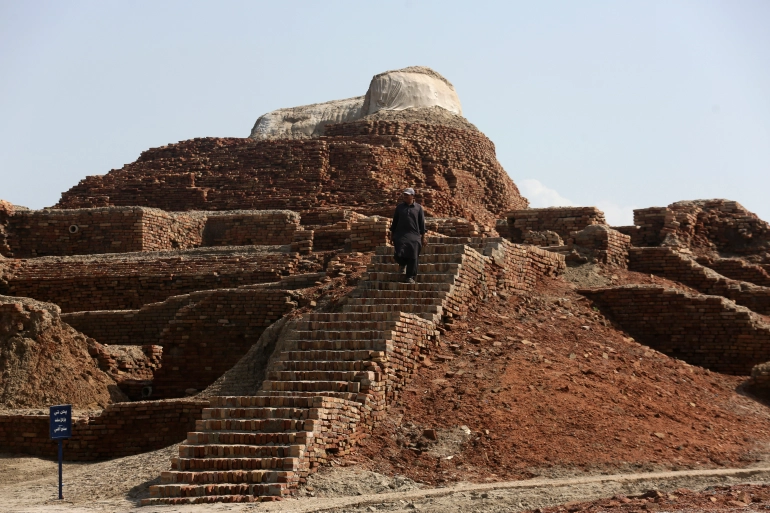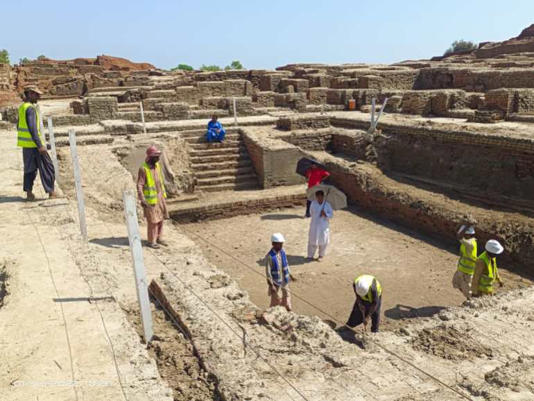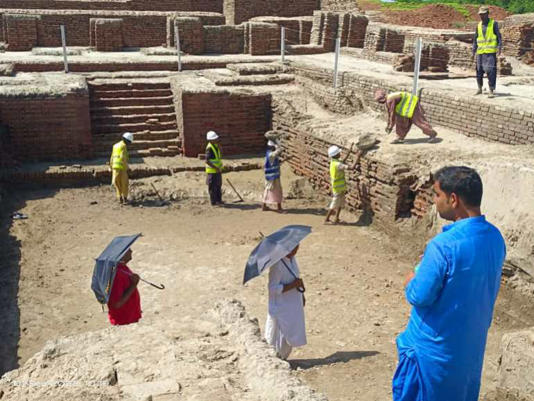Record rains in Pakistan damage Mohenjo Daro archaeological site
The devastating floods in Pakistan have caused significant damage to Mohenjo Daro, a famous 4,500-year-old archaeological site in the southeastern Sindh province which UNESCO has declared a World Heritage site.
The area in Sindh’s Larkana district received more than 1,400mm of rain in the second week of August, damaging the protective outer covering on the historic structures, Abdul Fatah Shaikh, the director of archaeology and museum for the provincial government, told Al Jazeera on Wednesday.
That amount of rain, Shaikh said, has not been recorded on the 250 hectares (650 acres) since the ruins were discovered 100 years ago in 1922.
“The original structure is safe by and large, including the stupa at the site. However, the protective layer, also called mud slurry, that we deployed suffered a lot of damage, causing exposure of the original walls,” Shaikh said over the telephone from Karachi city. Shaikh said the damage was caused mainly due to heavy rains and that there was no flooding, but added that urgent remedial work is required.

“The original structure is now exposed to the vagaries of nature and if immediate conservation work is not started, it can cause irreparable damage,” he warned.
Mohenjo Daro (‘Mound of the Dead’ in Sindhi language) – considered the best preserved urban settlement in South Asia – is situated on the bank of the Indus River, with Larkana being the nearest major city 30km (18 miles) away.
The ruins were declared a UNESCO World Heritage site in 1980.
Repair work underway
Shaikh rejected media reports that claimed the site could be removed from the heritage list after the rains damaged it, saying there was no such immediate risk.
“If a site is not conserved or protected properly, they are given suggestions to improve. If the (UNESCO) committee is not satisfied, a warning is issued to the host country. Often, these warnings are repeated for multiple years before a site is moved to a ‘danger list,” Shaikh said.
He said there are currently 52 World Heritage sites across the globe on the danger list, but none of them is in Pakistan.
“But this does not mean that we become complacent and fall asleep,” Shaikh said, adding that dozens of workers have begun the repair work.

“Many parts of the site are now exposed to nature and we must work extremely hard and very urgently for conservation within the next six months. It cannot be ruled out that if we fail to deliver, the site could be added to the danger list,” he added. Mohenjo Daro, one of the prominent cities of the Indus Valley Civilisation, is known for its elaborate drainage and water management systems. This, Shaikh said, played a role in ensuring there was very little standing water as floods hit the region.
“The city of Larkana had four feet of standing water whereas, at Mohenjo Daro, there was less than a foot of it. It proved that the original drainage system worked even 5,000 years after it was built,” he said.

Meanwhile, United Nations Secretary-General Antonio Guterres is expected to land in Pakistan later on Thursday “to appeal for the massive support of the international community to the Pakistanis, in this hour of need after the devastating floods that we are witnessing”.
“Today it is Pakistan. Tomorrow it can be anywhere else,” he said before flying, referring to the global threats caused by the climate crisis.
The Pakistani foreign ministry issued a statement on Thursday, confirming the arrival of Guterres.
“The Secretary-General will travel to areas most impacted by the climate catastrophe. He will interact with displaced families and first responders in the field, and oversee UN’s humanitarian response work,” the statement said.
Shaikh said the Pakistani government could use the UN chief’s visit to pitch for a global campaign to raise funds for Mohenjo Daro as well.
“We are also going to host a centenary function to celebrate 100 years of discovery of Mohenjo Daro in Paris this November as part of our Save Mohenjo Daro campaign,” he said.

In a news statement shared with Al Jazeera, UNESCO confirmed the agency will be providing $350,000 to Pakistan to “help recover flood-damaged cultural heritage sites” including Mohenjo Daro. Meanwhile, authorities in Pakistan said some cities in Sindh are still in danger of flooding after breaches were made in Manchar Lake, Pakistan’s largest freshwater lake, to save major urban settlements.
Mahesh Kumar, a government engineer in Sindh, told Al Jazeera the cuts in the lake have reduced the water level to below the danger mark. However, the breaches forced the evacuation of at least 100,000 people from the adjoining areas. Overnight, 12 more people died due to the floods, bringing the total death toll to 1,355 since June, 481 of them children, the National Disaster Management Authority said. At its peak, the record floods had submerged one-third of Pakistan.
Officials now fear the spread of water-borne diseases and other ailments in the affected areas as people lack access to clean water or medicines. The UN in a statement last week said up to 73,000 pregnant women are expected to deliver next month. Officials and climate activists say Pakistan is a victim of climate change since it contributes less than one per cent of global greenhouse gas emissions but is among the top 10 countries most vulnerable to extreme weather.





